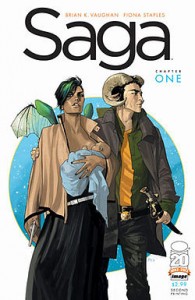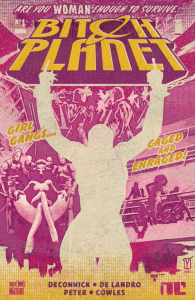As we’ve seen in a number of different texts, man examples of utopian/dystopian literature utilizes the trope of separate worlds to represent separate spheres of thought and influence on their populations. This tool draws a more stark and intentional divide between main groups in utopian/dystopian literature and through the creation of a social/political/technological polarity allows the consumer to more easily develop an understanding with either “side” and eventually a sense of sympathy or empathy for one world or the other, or both.
We’ve seen this used in The Dispossessed, with the physical, social, developmental, and political differences between Urras and Anarres. But I’ve found this notion in two other forms of media that I find equally interesting, similar, and absolutely badass. The first is a sci-fi, futuristic, feminist anti-utopia. Yeah, go ahead and drink that in. It’s a comic book called “Bitch Planet” and completely lives up to both its name and aggressive, captivating writing style. It is set in the relatively near future, one where political dissidents–particularly female dissidents–are sent to a maximum security jail that is located on a nearby planet.
These women, who have proven to be politically active, to opinionated, too ethnic, or generally disagreeable, are labelled as “non-compliant,” and are subject to brutal and arbitrary treatment while in captivity. Here, though the message of “Bitch Planet” is clearly a feminist one, the writer and illustrator–Kelly Sue DeConnick and Valentine De Landro–utilize the archetype of separate planets as separate spheres to demonstrate profound difference in views not only between planets, but on each planet. The prisoners, unsurprisingly, view Earth as an oppressive, patriarchal regime, while those on Earth, even the women, disturbingly, pity the non-compliants and believe that their punishment is deserved for the betterment of society, hoping desperately for their rehabilitation and later return.
Another example is from another phenomenal comic book by Fiona Staples and Brian K. Vaughn, called “Saga.” This story takes place in the much more distant future, where, for reasons yet unexplained, but shrouded in doubt of the brutal, aristocratic regime, a planet, Landfall, has gone to war with its own moon, Wreath. Here, the differences between the two worlds, not unlike in The Dispossessed, are physical, as well as political and social. The Landfallians are depicted with wings, and the Wreathians with horns. Wreath is also shown as a more of an impoverished and simple nation like Anarres, while Landfall is shown as affluent, and the home base for the oppressive Robot Kingdom, who has waged the war between the two, and are depicted as profiteering and morally challenged, not unlike Urras.
This structuring of worlds as separate spheres of thought is common in utopian/dystopian media, and I believe this to be the case because it is the starkest means through which to portray the creation of the “other.” Warring civilizations and politically disparate societies contain inherently differing ideals and mores. However, buy structuring two societies as literally worlds away from one another, the physical divide provides a dynamic all its own. More so than walls, which are another classic archetype of utopia/dystopia, separate worlds set a foundation of difference, of tension, on which to build two conflicting societies. I believe that, like The Dispossessed, “Saga,” and “Bitch Planet,” worlds featuring societies on separate and disparate planets are embedded with conflict and develop a story as much more utopian or dystopian than would be without this structure


